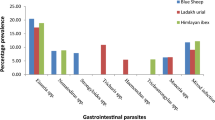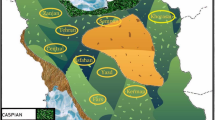Abstract
The gastrointestinal helminth fauna of 24 Barbary sheep or Aoudad (Ammotragus lervia sahariensis) maintained in the Parque de Rescate de la Fauna Sahariana (PRFS, CSIC, Almeria, Spain) was analyzed. Most animals (87.5 %) were parasitized, and multiple infections were highly present. The following species were identified: Camelostrongylus mentulatus, Teladorsagia circumcincta, Marshallagia marshalli, Ostertagia ostertagi, O. leptospicularis, O. lyrata, Haemonchus contortus, Teladorsagia trifurcata, Trichostrongylus vitrinus, T. colubriformis, T. probolorus, T. capricola, Nematodirus spathiger, N. abnormalis, N. filicollis, N. helvetianus, Trichuris spp. and Skrjabinema ovis. Teladorsagia circumcincta was the most prevalent nematode in abomasum (52.6 %) followed by C. mentulatus (50 %). However, this latter nematode had the greater mean intensity and abundance. In the small intestine, T. colubriformis and T. vitrinus had the highest prevalence (36.4 %); the last one showed also the greater mean intensity and abundance. It should be emphasized the presence of Skrjabinema ovis (prevalence 39.1 %) in the large intestine, showing the greater mean abundance and intensity, although with a low values. Camelostrongylus mentulatus could be the most primitive nematode of the family trichostrongylidae recovered in this study; attending to its high prevalence, mean abundance and mean intensity, the possible specificity between this parasite and the Aoudad is discussed.
Similar content being viewed by others
References
AEMET.es Madrid: Agencia Estatal de Meteorología, Gobierno de España (2012) [updated daily;]. http://www.aemet.es/es/eltiempo/prediccion/localidades/almeria-04001. Accessed 7 April 2012
Almería S, Vidal D, Ferrer D, Pabón M, Fernández de Mera MI, Ruiz-Fons F, Alzaga V, Marco I, Calvete C, Lavín S, Gortázar C, López-Gatius F, Dubey JP (2007) Seroprevalence of Neospora caninum in non-carnivorous wildlife from Spain. Vet Parasitol 143:21–28
Bowman D (2004) Georgis’ parasitology for veterinarians. Elsevier, Edimburgh
Boyce W, Allen J, Himmelwright C, Elliott L, Mikolon A, Mazet J, Gardner I (1991) Implementation and evaluation of a strategic parasite control program for captive exotic ungulates. J Am Vet Med Assoc 198:1972–1976
Brooks DR (1985) Historical ecology: a new approach to studying the evolution of Ecological Associations. Ann Mo Bot Gard 72:660–680
Bush AO, Lafferty KD, Lotz JM, Shostak AV (1997) Parasitology meets ecology on its own term: Magolis et al. revisited. J Parasitol 83:575–583
Cano A (1980) El Centro de Rescate de la Fauna Sahariana. In: Proceedings of the I Iberoamerican Zoology Vert. La Rábida, pp. 55–61
Cantalapiedra JL, Hernández Fernández M, Morales J (2006) Linajes fantasma y correlación con variables ecológicas: el caso de la Subfamilia Caprinae. Estud Geol 62:167–176
Cassinello J (1998) Ammotragus lervia: a review on systematics, biology, ecology and distribution. Ann Zool Fenn 35:149–162
Cassinello J, Gomendio M, Roldan ERS (2001) Relationship between coefficient of inbreeding and parasite burden in endangered gazelles. Conserv Biol 15:1171–1174
Chilton NB, Gasser RB, Beveridge I (1997) Phylogenetic relationships of Australian strongyloid nematodes inferred from ribosomal DNA sequence data. Int J Parasitol 27:1481–1494
Chilton NB, Newton LA, Beveridge I, Gasser RB (2001) Evolutionary relationships of trichostrongyloid nematodes (Strongylida) inferred from ribosomal DNA sequence data. Mol Phylogenet Evol 19:367–386
Church NW (1986) Gastro-intestinal nematodes in captive roan and sable antelope. Vet Rec 119:406–407
Cordero M, Castañón L, Reguera A (1994) Índice-Catálogo de Zooparásitos Ibéricos. Secretariado de Publicaciones Universidad de León, León
Cruz Reyes A, Camargo-Camargo B (2001) Glosario de términos en parasitología y ciencias afines. Plaza y Valdés, México
Durette-Desset MC (1971) Essai the clasification des Nématodes Héligmosomes. Corrélation avec la paléobiogéographie des hôtes. Mém Mus Hist Nat A 34:1–126
Durette-Desset MC (1985) Trichostrongyloid nematodes and their vertebrate hosts: reconstruction of the phylogeny of a parasitic group. Adv Parasitol 24:239–306
Durette-Desset MC (1989) Nomenclature proposée pour les espèces décrites dans la sous-famille des Ostertagiinae López-Neyra, 1947. Ann Parasitol Hum Comp 64:356–373
Durette-Desset MC, Beveridge I, Spratt DM (1994) The origins and evolutionary expansion of the Strongylida (Nematoda). Int J Parasitol 24:1139–1165
Durette-Desset MC, Hugot JP, Darlu P, Chabaud AG (1999) A cladistic analysis of the Trichostrongyloidea (Nematoda). Int J Parasitol 29:1065–1086
Flachd EJ, Sewell MMH (1987) Gastro-intestinal nematodiasis in Black-buck (Antilope cervicapra). The J Zoo Anim Med 18:56–61
Garrido G (2008) Generalidades sobre los artiodáctilos del Villafranquiense superior en relación con el registro fósil de Fonelas P-1. Cuad Mus Geomin 10:279–335
Gauss CBL, Dubey JP, Vidal D, Cabezón O, Ruiz-Fons F, Vicente J, Marco I, Lavín S, Gortázar C, Almería S (2005) Prevalence of Toxoplasma gondii antibodies in red deer (Cervus elaphus) and other wild ruminants from Spain. Vet Parasitol 136:193–200
Geist V (1971a) The relation of social evolution and dispersal in ungulates during the Pleistocene, with emphasis on the Old World Deer and the genus Bison. Quat Res 1:285–315
Geist V (1971b) Mountain sheep. A study in behaviour and evolution. The University of Chicago Press, Chicago
Geist V (1985) On evolutionary patterns in the Caprinae with comments on the punctuated mode of evolution. In: Lovari S (ed) The biology and management of mountain ungulates. Croom-Helm, London
González-Candela M, León-Vizcaíno L, Cubero-Pablo MJ (2004) Population effects of sarcoptic mange in Barbary sheep (Ammotragus lervia) from Sierra Espuña Regional Park, Spain. J Wildl Dis 40:456–465
González-Candela M, Serrano E, Martínez-Carrasco C, Martín-Atance P, Cubero MJ, Alonso F, León L (2009) Coinfection is an important factor in epidemiological studies: the first serosurvey of the Aoudad (Ammotragus lervia). Eur J Clin Microbiol 28:481–489
Goossens E, Dorny P, Boomer J, Vercammen F, Vercruisse J (2005) A 12-month survey of the gastro-intestinal helminthes of antelopes, gazelles and giraffids kept at two zoos in Belgium. Vet Parasitol 127:303–312
Hoberg EP (1997) Parasite biodiversity and emerging pathogens: a role for systematics in limiting impacts on genetic resources. In: Hoagland KE, Rossman AY (eds) Global genetic resources: access, ownership and intellectual property rights. Association of Systematics Collections, Washington DC, pp 71–83
Hoberg EP, Brooks DR (2008) A macroevolutionary mosaic: episodic host-switching, geographical colonization and diversification in complex host–parasite systems. J Biogeogr 35:1533–1550
Hoberg EP, Lichtenfels JR (1994) Phylogenetic systematic analysis of the Trichostrongylidae (Nematoda), with an initial assessment of coevolution and biogeography. J Parasitol 80:976–996
Ho-Seong C, Sung-Shik S, Nam-Yong P (2006) Balantidiasis in the gastric lymph nodes of Barbary sheep (Ammotragus lervia): an incidental finding. J Vet Sci 7:207–209
Hung GC, Chilton NB, Beveridge I, Gasser RB (2000) A molecular systematic framework for equine strongyles based on ribosomal DNA sequence data. Int J Parasitol 30:95–103
Karanis P, Plutzer J, Halim NA, Igori K, Nagasawa H, Ongerth J, Liging M (2007) Molecular characterization of Cryptosporidium from animal sources in Qinghai province of China. Parasitol Res 101:1575–1580
Kock RA (1986) Enteric nematode infestation in Thomson’s gazelles, Gazelle thomsoni, at Whipsnade Park, the Zoological Society of London. J Zoo Anim Med 17:61–64
Krasnov BR, Shenbrot GI, Khokhlova IS, Poulin R (2004) Relationships between parasite abundance and the taxonomic distance among parasite’s host species: an example with fleas parasitic on small mammals. Int J Parasitol 34:1289–1297
Lichtenfels JR (1987) Phylogenetic inference from adult morphology in the Nematoda; with emphasis on the bursate nematodes, the Strongylida; advancements (1982–1985) and recommendations for further work. Int J Parasitol 17:269–279
López C, Vericad JR (1993) Audad, Ammotragus lervia, del Sahara Occidental. Bol Inst Estud Almer Ciencias 65:71–81
Manca L, Pirastru M, Mereu P, Multineddu C, Olianas A, el Sherbini S, Franceschi P, Pellegrini M, Masala B (2006) Barbary sheep (Ammotragus lervia): the structure of the adult beta-globin gene and the functional properties of its hemoglobin. Comp Biochem Physiol B 145:214–219
Manual of Veterinary Parasitological Laboratory Techniques (1989) Ministry of Agriculture, Fisheries and Food, London
Margolis L, Esch GW, Holmes JC, Kuris AM, Schad GA (1982) The use of ecological terms in parasitology (Report of an ad hoc committee of the American Society of Parasitologists). J Parasitol 68:131–133
Mereu P, Palici di Suni M, Manca L, Masala B (2008) Complete nucleotide mtDNA sequence of Barbary sheep (Ammotragus lervia). DNA Seq 19:241–245
Newby JE, Jones DM (1981) An ecological survey of the Takolokouzet massif and surrounding area in the Eastern Air Mountains Republic of Niger. Government of Republic of Niger, Z.S.L., IUCN, Quest 80Lrd; Fauna and Flora Preservation Society
Newton LA, Chilton NB, Beveridge I, Gasser RB (1998) Systematic relationships of some members of the genera Oesophagostomum and Chabertia (Nematoda: Chabertiidae) based on ribosomal DNA sequence data. Int J Parasitol 28:1781–1789
Ortiz JM, Goyena M, Alonso F (1996) First report of two polymorphic species of Ostertagia (nematode: trichostrongyloidea) in Cervus elaphus in Spain: O. leptospicularis and O. kolchida. Res Rev Parasitol 56:221–223
Ortiz JM, Ruiz de Ybáñez MR, Goyena M (2000) First report of Trichostrongylus probolorus (Railliet, 1896) Looss, 1905 (Nematoda: Trichostrongyloidea) in Spain. Res Rev Parasitol 60:137–138
Ortiz J, Ruiz de Ybáñez MR, Garijo MM, Goyena M, Espeso G, Abáigar T, Cano M (2001) Abomasal and small intestinal nematodes from captive gazelles in Spain. J Helminthol 75:363–365
Ortiz J, Ruiz de Ybáñez R, Abaigar T, Goyena M, Garijo M, Espeso G, Cano M (2006) Output of gastrointestinal nematode eggs in the feces of captive gazelles (Gazella dama mhorr, Gazelle cuvieri and Gazella dorcas neglecta) in a semiarid region of southeastern Spain. J Zoo Wildl Med 37:249–254
Pence DB, Gray GG (1981) Elaeophorosis in Barbary sheep and mule deer from the Texas Panhandle. J Wildl Dis 17:49–56
Ruiz de Ybáñez MR, Garijo MM, Carpintero M, Martínez-Carrasco C, Ortiz JM (2003) Camelostrongylus mentulatus in domestic goats from the Iberian Peninsula. J Helminthol 77:371–372
Ruiz de Ybáñez MR, Goyena M, Abaigar T, Garijo MM, Martínez-Carrasco C, Espeso G, Cano M, Ortiz JM (2004) Periparturient increase in faecal egg counts in a captive population of mohor Gazella (Gazella dama mhorr). Vet Rec 154:49–52
Skrjabin KI, Shikhobalova NP, Schulz RS, Popova TI, Boev SN, Delyaure SL (1961) Key to parasitic nematodes. Vol III. Strongylata. The Academy of Sciences of the USSR. Israel Program for Scientific Translation, Jerusalem
Yamaguti S (1961) Systema helminthum Vol. III The nematodes of vertebrates. Intersience Publishers Inc, New York
Yeruham I, Rosen S, Nyska A (1996) Sarcoptic mange in wild rumiants in zoological gardens in Israel. J Wildl Dis 32:57–61
Acknowledgments
The authors are grateful to the executive and staff of Parque de Rescate de la Fauna Sahariana. Estación Experimental de Zonas Áridas. CSIC, for the permission and help for collecting the samples.
Author information
Authors and Affiliations
Corresponding author
Rights and permissions
About this article
Cite this article
Mayo, E., Ortiz, J., Martínez-Carrasco, C. et al. First description of gastrointestinal nematodes of Barbary sheep (Ammotragus lervia): the case of Camelostrongylus mentulatus as a paradigm of phylogenic and specific relationship between the parasite and its ancient host. Vet Res Commun 37, 209–215 (2013). https://doi.org/10.1007/s11259-013-9563-0
Accepted:
Published:
Issue Date:
DOI: https://doi.org/10.1007/s11259-013-9563-0




